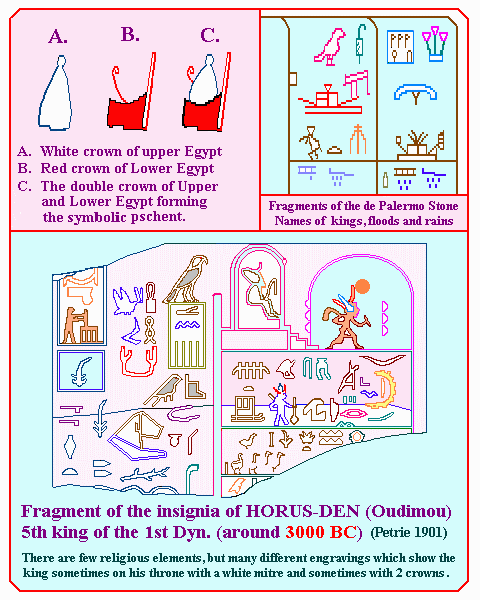
The Pharaohs
HORUS-DEN and HORUS-KA |
REIGN OF THE PHARAOH : HORUS-DEN (OUDIMOU)
From the year 3000 BC Egypt was governed by the fifth pharaoh Den-Ousaphais (the man of the Desert), who succeeded his father Ouadji-Djer (the serpent king).
Remembering the terrible famine which Egypt suffered driving the reign of the previous pharaoh, (probably due to drought caused by insufficient flooding silt from the Nile), Den-Ousaphais started the construction of a new network of canals and reservoirs. This work was completed by his successors.
This great pharaoh, who managed to maintain peace between Upper and Lower Egypt, also led several campaigns beyond the frontiers to conquer :
After thirty years as pharaoh, Horus Den organized a great celebration for his people. This celebration had taken place on the thirtieth anniversary of each pharaoh’s reign during the predynastic period.
Soon certain pharaohs, wanting to please the people, gave them another feast on the twentieth or twenty fifth anniversary too. Later the Hebrews adopted this idea, but had the celebration every fifty years. This was called their jubilee year where they redistributed some of their land, paid debts to their brothers (meaning to those of the same religion) and even set free slaves.
REIGN OF THE PHARAOH: Horus-Ka (Qaa) / OUBIANTHES
The first dynasty ended after the reign of Horus-Ka, about 2915 BC. For reasons unknown power passed into the hands of a new dynasty of Thinite origin in the city of Abydos (in the former region of Thebes).
Except for some artifacts found in some tombs or mastabas (monuments to the dead), we know little about the daily life, the conquests and beliefs of the pharaohs of the first two dynasties. Our aim is to study the religious reforms and evolution of ancient spirituality, so first we shall examine the various dynasties, and also the religious writings found in Egypt. The latter were the precursor of the Bible and of social morality, but they came about mainly because the pharaohs became aware that new horizons were opening up to them : of a new life after death, and this carried over into the spiritual life of the people.
The first official CODE of good conduct evolved during the time of the official royal dynasties, between 3000 BC and 2730 BC, which lasted until the third official dynasty, and thus long before the decree of the famous civil code inspired by the Mesopotamian king HAMMURABI (around 1730 BC).

Table of the second (official) dynasty of the Pharaohs :
Names of Pharaohs of the " SECOND DYNASTY
" |
||
Royal lists - (1 to 5 Helck) 1987 and 6 to 9 Grdseloffs 1944 |
Royal lists according to |
Lists of Manethon |
| A. Horus/Seth list B. Nesout-Bity list |
C. |
D. |
| 1.A Hoteps - Sekhemouy 1.B Hoteps |
1. Bedjaou Baou-Nefer |
1. Boethos |
| 2.A Nebres or Ranebs 2.B Noubnefers |
2. Kakaou | 2. Kaiechos |
| 3.A and B. Nineters | 3. Baneteren | 3. Binothris |
| 4.A?? - B. Ouneg | 4. Ouadjenes | 4. Tlas |
| 5.A and B. Senedjs | 5. Senedj | 5. Senethes |
| 6.A Horus Sekhemibs 6.B Perenmaats |
6. Aka (or Nebka?) | 6. Chairos |
| 7.A Seth Peribsens | 7. Neferkare | 7. Neferkares |
| 8.A Horus Khasekhems | 8. Neferkare-Sokar | 8. Sesochis |
| 9.A Kasekhemouys 9.B Nebouy Hotep-imefs |
9. Houdjefa 10 years ou Beby? |
9. Cheneres |
The names listed as "A" give the name inscribed in the royal list of Horus & Set. These 2 gods were reunited (Hories was the god of the southern kingdom and Set, the protector of the kingdom of the North (Delta) became with the pharaoh the guardians of peace and prosperity in the two kingdoms.
When a different name appears after the letter B, this corresponds to the same pharaoh inscribed on the second list of Nesout Bity or Nebty, Nesout being the hieroglyphic for the reed, which was the symbol of Upper Egypt.
If the Egyptologists agree on the names and reigns of the first 3 pharaohs of the 2nd dynasty there are still controversies over the classification and names of the next 4 kings. It seems that a sudden civil war separated the 2 kingdoms again and they were not reconciled until the reign of Kha-Sekhmouy. This explains the discrepancies in the reigns, and the existence of 2 dynasties which ruled over the 2 different kingdoms of the north and the south.
o - o - o - o - o - o - o